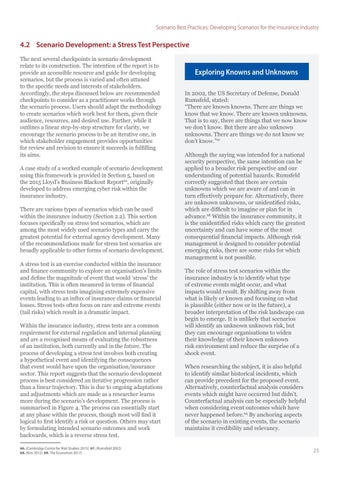Scenario Best Practices: Developing Scenarios for the Insurance Industry
4.2 Scenario Development: a Stress Test Perspective The next several checkpoints in scenario development relate to its construction. The intention of the report is to provide an accessible resource and guide for developing scenarios, but the process is varied and often attuned to the specific needs and interests of stakeholders. Accordingly, the steps discussed below are recommended checkpoints to consider as a practitioner works through the scenario process. Users should adapt the methodology to create scenarios which work best for them, given their audience, resources, and desired use. Further, while it outlines a linear step-by-step structure for clarity, we encourage the scenario process to be an iterative one, in which stakeholder engagement provides opportunities for review and revision to ensure it succeeds in fulfilling its aims. A case study of a worked example of scenario development using this framework is provided in Section 5, based on the 2015 Lloyd’s Business Blackout Report66, originally developed to address emerging cyber risk within the insurance industry. There are various types of scenarios which can be used within the insurance industry (Section 2.2). This section focuses specifically on stress test scenarios, which are among the most widely used scenario types and carry the greatest potential for external agency development. Many of the recommendations made for stress test scenarios are broadly applicable to other forms of scenario development. A stress test is an exercise conducted within the insurance and finance community to explore an organisation’s limits and define the magnitude of event that would ‘stress’ the institution. This is often measured in terms of financial capital, with stress tests imagining extremely expensive events leading to an influx of insurance claims or financial losses. Stress tests often focus on rare and extreme events (tail risks) which result in a dramatic impact. Within the insurance industry, stress tests are a common requirement for external regulation and internal planning and are a recognised means of evaluating the robustness of an institution, both currently and in the future. The process of developing a stress test involves both creating a hypothetical event and identifying the consequences that event would have upon the organisation/insurance sector. This report suggests that the scenario development process is best considered an iterative progression rather than a linear trajectory. This is due to ongoing adaptations and adjustments which are made as a researcher learns more during the scenario’s development. The process is summarised in Figure 4. The process can essentially start at any phase within the process, though most will find it logical to first identify a risk or question. Others may start by formulating intended scenario outcomes and work backwards, which is a reverse stress test. 66. (Cambridge Centre for Risk Studies 2015) 67. (Rumsfeld 2002) 68. (Kim 2012) 69. The Economist 2017)
Exploring Knowns and Unknowns In 2002, the US Secretary of Defense, Donald Rumsfeld, stated: “There are known knowns. There are things we know that we know. There are known unknowns. That is to say, there are things that we now know we don’t know. But there are also unknown unknowns. There are things we do not know we don’t know.”67 Although the saying was intended for a national security perspective, the same intention can be applied to a broader risk perspective and our understanding of potential hazards. Rumsfeld correctly suggested that there are certain unknowns which we are aware of and can in turn effectively prepare for. Alternatively, there are unknown unknowns, or unidentified risks, which are difficult to imagine or plan for in advance.68 Within the insurance community, it is the unidentified risks which carry the greatest uncertainty and can have some of the most consequential financial impacts. Although risk management is designed to consider potential emerging risks, there are some risks for which management is not possible. The role of stress test scenarios within the insurance industry is to identify what type of extreme events might occur, and what impacts would result. By shifting away from what is likely or known and focusing on what is plausible (either now or in the future), a broader interpretation of the risk landscape can begin to emerge. It is unlikely that scenarios will identify an unknown unknown risk, but they can encourage organisations to widen their knowledge of their known unknown risk environment and reduce the surprise of a shock event. When researching the subject, it is also helpful to identify similar historical incidents, which can provide precedent for the proposed event. Alternatively, counterfactual analysis considers events which might have occurred but didn’t. Counterfactual analysis can be especially helpful when considering event outcomes which have never happened before.69 By anchoring aspects of the scenario in existing events, the scenario maintains it credibility and relevancy.
23








